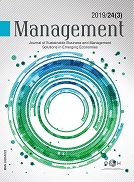Forecasting Foreign Institutional Investment Flows towards India Using ARIMA Modelling
Abstract
India has witnessed substantial increase in capital flows, particularly Foreign Institutional Investment in equity as well as derivatives segment since the 1990s. However, FII flows are sighted as ‘hot money’- more volatile than other type of flows, which gets affected by the domestic and global- macro economic factors, thereby raising questions about the need to encourage FII flows in narrow and shallow (in terms of absorption capacity) capital market such as India. This paper attempts to forecast daily Aggregate FII flow in Indian Capital market and particularly in Futures Market (Derivative Segment) using Auto Regressive Integrated Moving Average (ARIMA) model.The paper tries to examine FII flows in India towards futures market along with spot market by tracing which AR terms and/or MA terms influence the current inflow or outflow.

This work is licensed under a Creative Commons Attribution-NonCommercial-NoDerivatives 4.0 International License.

















